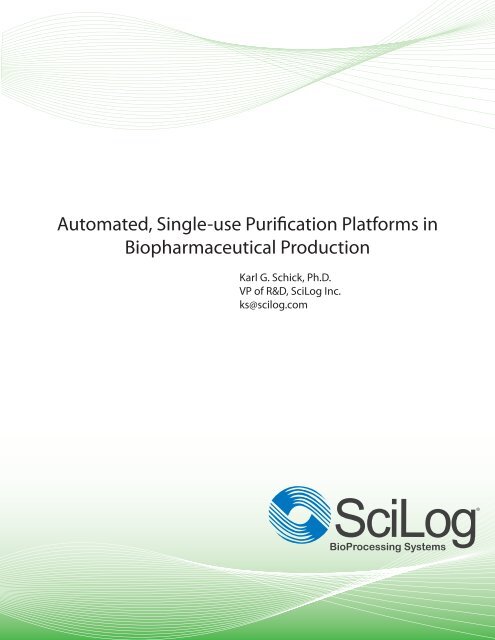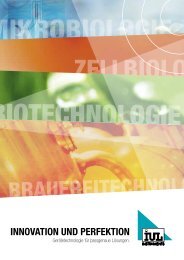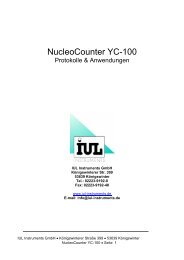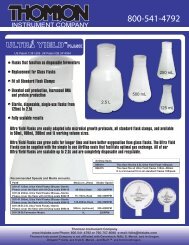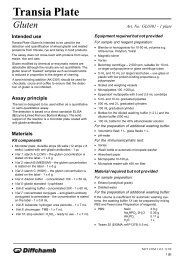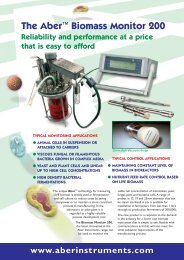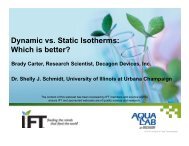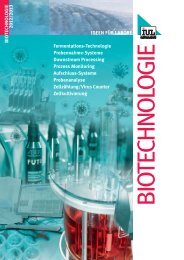Automated, Single-use Purification Platforms in ... - SciLog, Inc.
Automated, Single-use Purification Platforms in ... - SciLog, Inc.
Automated, Single-use Purification Platforms in ... - SciLog, Inc.
Create successful ePaper yourself
Turn your PDF publications into a flip-book with our unique Google optimized e-Paper software.
<strong>Automated</strong>, <strong>S<strong>in</strong>gle</strong>-<strong>use</strong> <strong>Purification</strong> <strong>Platforms</strong> <strong>in</strong>Biopharmaceutical ProductionKarl G. Schick, Ph.D.VP of R&D, <strong>SciLog</strong> <strong>Inc</strong>.ks@scilog.comBioProcess<strong>in</strong>g Systems
In addition, the spectrum of process variables def<strong>in</strong><strong>in</strong>g the purification process must be accessible tomonitor<strong>in</strong>g and control. At a m<strong>in</strong>imum, this may require the <strong>in</strong>stallation of appropriate sensor anddetectors for cont<strong>in</strong>uous monitor<strong>in</strong>g of pressure, flow rates and temperature. In addition, the quality ofthe purification process itself must be monitored with <strong>in</strong>-l<strong>in</strong>e chemical sensors, i.e. pH, conductivity or UVdetectors. For example, sensors of this type can provide early recognition of filter break-through eventsthat otherwise may rema<strong>in</strong> undetected dur<strong>in</strong>g batch process<strong>in</strong>g.Improved Process Knowledge: Consistent high product quality can only be achieved through cont<strong>in</strong>uousprocess and product improvements guided by improved process knowledge. By compar<strong>in</strong>g bench-markdata for a given purification process with historical data collected under different conditions, new process<strong>in</strong>sights can be ga<strong>in</strong>ed which lead to improved process tun<strong>in</strong>g, thereby reduc<strong>in</strong>g process variability andimprove product quality.The concept of cont<strong>in</strong>uous process and product improvement is well established and its benefits arerecognized across many <strong>in</strong>dustries. The biopharmaceutical <strong>in</strong>dustry has historically relied on standardoperat<strong>in</strong>g procedures (SOP) and manual batch-production records (BPR) to meet production as well asregulatory requirements. Concerns regard<strong>in</strong>g regulatory non-compliance seemed to make cont<strong>in</strong>uousprocess improvements an <strong>in</strong>compatible objective.However more recently, the biopharmaceutical <strong>in</strong>dustry has been <strong>in</strong>creas<strong>in</strong>gly rely<strong>in</strong>g on <strong>in</strong>tegrated digitalautomation systems (DAS) and electronic batch-production records to meet regulatory requirements. Thebatch management software and batch historian provide the data for the electronic batch-productionrecord. With DAS technology <strong>in</strong> place, cont<strong>in</strong>uous process and product improvement becomes anachievable objective. With<strong>in</strong> the biopharmaceutical <strong>in</strong>dustry, the Delta V (Emerson Process Management)platform has become the preferred process control system. The Food and Drug Adm<strong>in</strong>istration (FDA) isactively encourag<strong>in</strong>g biopharmaceutical companies do adopt newer technologies to meet regulatoryrequirements.<strong>Automated</strong>, <strong>S<strong>in</strong>gle</strong>-<strong>use</strong> Platform for Normal Flow Filtration (NFF): Normal Flow Filtration, aka DirectFlow Filtration, is extensively <strong>use</strong>d <strong>in</strong> the filtration of biopharmaceutical solutions, <strong>in</strong>clud<strong>in</strong>g filtration ofdilute solutions of prote<strong>in</strong>s, monoclonal antibodies and vacc<strong>in</strong>es. The solution is pumped through amembrane or depth filtration device of aselected porosity and surface area. Inselect<strong>in</strong>g appropriate filter porosity, as<strong>in</strong>gle-step separation of certa<strong>in</strong>undesirable solution constituents can oftenbe achieved. In a typical NFF setup, theprocess solution enters the filtration deviceat a constant pump rate. The undesirableconstituents are trapped by the filter andaccumulate on the <strong>in</strong>let filter surface;result<strong>in</strong>g <strong>in</strong> a progressive <strong>in</strong>crease <strong>in</strong> thefilter differential pressure. The NFF processis term<strong>in</strong>ated when the differentialpressure reaches a maximum allowable value designated by the filter manufacturer. Any further <strong>in</strong>creasebeyond this pressure limit can potentially result <strong>in</strong> rupture of the filter and leakage of undesirable materialacross the filter matrix.Page 3 of 11
Third, when the process solution reservoir is placed on an electronic scale (optional) the pump controllermeters the solution by weight based on the scale read<strong>in</strong>g. Dispens<strong>in</strong>g or meter<strong>in</strong>g by weight can typicallyprovide accuracy levels of 99.5% or better, i.e. the dispens<strong>in</strong>g <strong>in</strong>accuracy is less than 0.5%.The <strong>in</strong>creased filtration yield of the <strong>SciLog</strong> liquid handl<strong>in</strong>g approach is application and product dependent.However, simple laboratory-scale flow rate experiments (FilterTec) will provide scalable filtration yielddata for a given solution and filter. The <strong>SciLog</strong> systems conta<strong>in</strong> application software to implementoptimized filtration parameters. This can be achieved by implement<strong>in</strong>g either a constant or aprogrammable pump rate/pressure fluid delivery. For example, it is frequently advantageous to start theNFF process at low pump rate or pressure and <strong>in</strong>crease the pump rate or pressure over time until anapplication-specific pressure limit has been reached. From this po<strong>in</strong>t on, the fluid delivery willautomatically ma<strong>in</strong>ta<strong>in</strong> the pressure limit by modulat<strong>in</strong>g the pump output. At constant filter back pressure,the pump rate will decay over time beca<strong>use</strong> of progressive filter clogg<strong>in</strong>g as shown <strong>in</strong> Figure 2. Thefiltration process stops once a <strong>use</strong>r-def<strong>in</strong>ed lower pump rate limit has been reached and the result<strong>in</strong>gfiltrate collection rate has become negligible.The <strong>SciLog</strong> NFF method is particularly advantageous <strong>in</strong> the quantitative filtration of high-value products,i.e. monoclonal antibodies, prote<strong>in</strong>s and vacc<strong>in</strong>es. <strong>SciLog</strong>’s automated NFF procedure provides maximumfiltration yield while ma<strong>in</strong>ta<strong>in</strong><strong>in</strong>g safe filtration conditions at all times. The <strong>use</strong> of an electronic scaletogether with NFF system OPC connectivity provides full documentation of process parameters and yielddata.In addition, the <strong>SciLog</strong> liquid handl<strong>in</strong>g approach is well suited for automated, closed-loop NFF applicationswhere solution is removed from a s<strong>in</strong>gle-<strong>use</strong> bioreactor, filtered and stored <strong>in</strong> s<strong>in</strong>gle-<strong>use</strong> bags for futureprocess<strong>in</strong>g. <strong>SciLog</strong> provides a range of custom design, manufactur<strong>in</strong>g and service support capabilities.B: Disposable Sensor TechnologySensors designed for <strong>in</strong>corporation <strong>in</strong>to disposable purification platforms, i.e. s<strong>in</strong>gle-<strong>use</strong> Tangential FlowFiltration (TFF), s<strong>in</strong>gle-<strong>use</strong> Normal Flow Filtration (NFF) platforms or disposable chromatography platformsmust meet a number of challeng<strong>in</strong>g requirements.<strong>S<strong>in</strong>gle</strong>-<strong>use</strong> platforms for downstream purification typically consist of an <strong>in</strong>tegrated assembly of filterelements or columns, flexible tub<strong>in</strong>g, plastic connectors and bags, segments of peristaltic pump tub<strong>in</strong>g aswell as sensors. Such assemblies are designed and pre-assembled for a specific purification process and agiven, maximum process volume. Special, aseptic plastic connectors are <strong>use</strong>d to hook up to external,s<strong>in</strong>gle-<strong>use</strong> bioreactors and/or buffer solutions. In the f<strong>in</strong>al configuration, all elements of the purificationplatform are pre-sterilized, assembled and operated as a closed system.<strong>S<strong>in</strong>gle</strong>-<strong>use</strong> purification assemblies are typically custom-manufactured and gamma-irradiated at 30-40 kGyto <strong>in</strong>sure sterility of the <strong>in</strong>tegrated assembly. Alternative sterilization approaches are available utiliz<strong>in</strong>g“Steam-Thru” connectors as well as steam sterilized, disposable purification assemblies. Ethylene oxidesterilization appears to be <strong>use</strong>d less frequently beca<strong>use</strong> of potential contam<strong>in</strong>ation by residual ethyleneoxide.Page 5 of 11
<strong>SciLog</strong> <strong>Inc</strong>. has recently <strong>in</strong>troduced a family of disposable <strong>in</strong>-l<strong>in</strong>e sensors (Figure 4) for monitor<strong>in</strong>gconductivity (SciCon), pressure (SciPres) and temperature (SciTemp). These pre-calibrated sensors come <strong>in</strong>five different sizes, rang<strong>in</strong>g from Luer, 3/8” Barb, ½” Barb, ¾” TC to 1.0” TC and accommodate the<strong>in</strong>dustry’s need for system scalability. The performance characteristics of the <strong>SciLog</strong> sensors aresummarized:Sensor Calibration: Ma<strong>in</strong>ta<strong>in</strong><strong>in</strong>gsterility of s<strong>in</strong>gle-<strong>use</strong> purificationplatforms is of the highestimportance. Thus field calibration ofsensors and <strong>in</strong>sertion of sensors <strong>in</strong>to apre-sterilized purification manifold isnot an acceptable option beca<strong>use</strong> ofthe obvious contam<strong>in</strong>ation concerns.A primary, post-<strong>use</strong> sensor calibrationis equally unacceptable beca<strong>use</strong> ofuncerta<strong>in</strong>ty of the <strong>in</strong>-<strong>use</strong> sensoraccuracy and precision. However,secondary post-<strong>use</strong> sensorperformance verification may be<strong>use</strong>ful to metrology departmentsprovided the pre-<strong>use</strong> sensor performance is known and has been fully characterized.In this context, sensor characterization will answer the questions related to sensor performance aftergamma-irradiation, steam-sterilization (Temperature >121° C) under pressure (~20psi) and exposure tohigh concentrations of NaOH (1.0 Normal). These are the conditions that sensors will be exposed to when<strong>in</strong>tegrated <strong>in</strong>to down-stream, s<strong>in</strong>gle-<strong>use</strong> purification platforms. The <strong>SciLog</strong>’s family of sensors has beendesigned to provide accurate data after exposure to such harsh and challeng<strong>in</strong>g conditions. <strong>SciLog</strong>’sapproach of sensor pre-calibration, sensor characterization and full sensor performance disclosure hasbeen well received by the biopharmaceutical process community.Sensor Specific Information:Pre-calibrated Sensors: In order to implement a sensorcalibration, the <strong>SciLog</strong> sensor is exposed to a set of knowncalibration conditions. The sensor response is stored togetherwith the calibration value. For example, the standard factorycalibration procedure for the <strong>SciLog</strong> pressure sensor (SciPres) callsfor the sensor to be calibrated at a 0.00 psi applied pressure andat a 30.00 psi applied pressure utiliz<strong>in</strong>g digital, NIST traceablepressure gauges. Based on the sensor response a sensorCalibration Factor (CF) and sensor Zero Offset (PZ) are calculatedand stored <strong>in</strong> a proprietary sensor memory together with a uniquesensor ID. For each SciPres sensor, a sensor-specific CalibrationCertificate is issued and accompanies the sensor shipment. Thesensor ID code conta<strong>in</strong>s the follow<strong>in</strong>g sensor–specific <strong>in</strong>formation:CX-ZLLNNNN-MMYYCX = Pressure Sensor ConnectorC1=Luer,C2= 3/8”Barb,C3 = ½”Barb,C4= ¾” TC,C5=1.0” TCZ = Sensor Material Code,Z=1, Polysulfone,Z=2, PolypropyleneL = Sensor Production Lot NumberN = Sensor Serial NumberM = Month of Sensor CalibrationY = Year of Sensor CalibrationOn request, <strong>SciLog</strong> provides a Sensor Material Traceability Service which <strong>in</strong>cludes Sensor ExtractableReports, Material Lot Certification, as well as Product Certificates of Compliance.Page 6 of 11
Sensor Performance: For special sensor applications, <strong>SciLog</strong> offers a customer specific sensor calibrationservice. For example, oxygen gas addition to s<strong>in</strong>gle-<strong>use</strong> bioreactor bags requires careful pressuremonitor<strong>in</strong>g. Depend<strong>in</strong>g on bioreactor bag size, excessive gas pressures <strong>in</strong> the 1-5 psi range may ca<strong>use</strong>sudden rupture of the bioreactor. Users of s<strong>in</strong>gle-<strong>use</strong> bioreactors frequently request gamma-stablepressure sensors that are calibrated at 5.00 psi and capable of monitor<strong>in</strong>g low-level pressures, <strong>in</strong> the 1.00to 5.00 psi range, with 1.5% accuracy.A similar problem exists when overfill<strong>in</strong>g s<strong>in</strong>gle-<strong>use</strong> bags caus<strong>in</strong>g an excessive build-up of <strong>in</strong>ternal bagpressure. If not relieved, the pressure build-up can ca<strong>use</strong> bag rupture. <strong>Inc</strong>orporat<strong>in</strong>g the SciPres sensors<strong>in</strong>to bag <strong>in</strong>let will not only monitor the bag pressure but also stop fill<strong>in</strong>g operation when a <strong>use</strong>r-def<strong>in</strong>edpressure level has been exceeded. SciPres monitor has digital alarm outputs that can be <strong>use</strong>d for thispurpose.Although the SciPres pressure sensors have been safety-tested up to 90 psi, the standard operat<strong>in</strong>g rangeis limited to 60 psi. The SciPres Sensor Calibration Certificate <strong>in</strong>cludes the specific calibration po<strong>in</strong>ts as wellas the sensor-specific calibration factors (CF). The specific cal factor variations from the lot average CFrepresent the variances with<strong>in</strong> the manufactur<strong>in</strong>g tolerances of the proprietary solid-state sens<strong>in</strong>gelement. The sens<strong>in</strong>g element is covered by a medical grade silicone gel diaphragm (USP Class VI) capableof withstand<strong>in</strong>g a 100-hour exposure to sodium hydroxide solution (1.0N), see Sensor Characterization.When connected to SciPres monitor, the sensor-specific CF value is <strong>use</strong>d <strong>in</strong> a monitor-based correctionalgorithm that compensates for the slight sensor non-l<strong>in</strong>earity. The pressure values displayed by themonitor as well as the pressure values communicated by the monitor’s analog (4-20mA) and digitaloutputs represent accurate, CF-corrected pressure values.Sensor Performance Characterization: All <strong>SciLog</strong> sensors, <strong>in</strong>clud<strong>in</strong>g the SciPres pressure sensors, havebeen performance-tested under three different conditions. The sensor test protocols as well as test resultsare summarized below:Post-Gamma Sensor Response: 14 randomly selected SciPres pressure sensors were calibrated at 0.00 psiand 30.00 psi prior to gamma-irradiation at 38.4 kGy. Post-gamma sensor accuracy was determ<strong>in</strong>ed at 0.00psi and 30.00 psi of applied pressure, see Table I.Test Results: All sensors survived gamma-irradiationand tested accurately well with<strong>in</strong> <strong>SciLog</strong>’s establishedaccuracy limit of +/- 0.35 psi. The post-gamma datashows a group average of 29.96 psi (for 14 SciPres,¾”TC) with a standard deviation of +/- 0.03 psi.Post-Autoclav<strong>in</strong>g Sensor Response: Six randomlyselected SciPres sensors (1/2” Barb) were tested afterrepeated exposures (3x) to autoclave conditions, seeTable II. The <strong>in</strong>itial, factory calibration responses aretabulated under “Pre-Autoclave” head<strong>in</strong>g. Theambient air vent as well as the electrical connector ofSciPres sensor was covered with autoclave tape andplace <strong>in</strong>to a Tuttnauer EZ9 Autoclave. The follow<strong>in</strong>gPage 7 of 11
autoclave conditions were ma<strong>in</strong>ta<strong>in</strong>ed dur<strong>in</strong>g the three test trials:Sterilization Temperature:Sterilization Time:Sterilization Pressure:Dry<strong>in</strong>g Time:257°F (125°C)30 m<strong>in</strong>utes19 psi30 m<strong>in</strong>utesAfter each trial, the SciPres sensors were allowed to cool to room temperature and pressure tested at 0.00psi and 30.00 psi. The SciPres response data are listed under the “Post Trial” columns. All trials werecarried out with the orig<strong>in</strong>al factory sensor calibration. No sensor re-calibrations were made before ordur<strong>in</strong>g the three trials.Test Result: All of the tested SciPres sensors survived autoclave conditions. For the tested sensors (6), thegroup average ranged from 29.99 to 30.11 with an average standard deviation of +/- 0.06 psi. However,sensor accuracy became <strong>in</strong>creas<strong>in</strong>gly compromised after two autoclave cycles. For accurate performance,SciPres sensors are limited to two autoclave cycles.Sodium Hydroxide Exposure Test: Six randomly selected SciPres sensors (Luer) were tested after a 100-hourexposure to 1.0 N sodium hydroxide solution at 22°C and at 10 psi l<strong>in</strong>e pressure, see Table III. The sodiumhydroxide solution was cont<strong>in</strong>uously re-circulated (150ml/m<strong>in</strong>) through the sensors us<strong>in</strong>g a peristalticpump. At 25 hour <strong>in</strong>tervals, the exposure test was briefly <strong>in</strong>terrupted, the sensor were flushed withdistilled water and tested at 0.00 psi and 30.00psi.Test Result: The data show a stable sensor accuracy and precision over the 100-hour exposure to 1.0 Nsodium hydroxide solution. For the four timed exposure tests, the group averages ranged from 30.06 toPage 8 of 11
30.08 psi with an average standard deviation of +/- 0.06 psi. All sensor responses were monitored with adigital, NIST-traceable gauge.Sensor Accuracy & Precision: The SciPres sensor accuracy, based on performance data sensor lot of 250sensors, has been established to be +/- 0.35 psi for the 0 – 60 psi applied pressure range. “Out-of-Box”sensor performance has been tested. For 12 randomly selected, factory pre-calibrated SciPres sensors, the“Out-of-Box” accuracy was 30.07 psi +/- 0.07 psi (NIST test pressure: 30.00 psi) with test results rang<strong>in</strong>gfrom 29.96 to 30.19 psi.Sensor Monitors: The SciPres laboratory monitor is designed accommodate up to three SciPres sensorssimultaneously. The monitor displays the three pressure sensors as P1, P2, and P3. In addition, the monitorwill also display the differential pressure DP = (P1-P2) or the TFF trans-membrane pressure TM =[(P1+P2)/2] - P3. Furthermore, four analog outputs (4-20mA) are available: P1, P2, P3, DP or TM. The fouranalog output signals have an 18 bit resolution. Four TTL output alarms provide <strong>use</strong>r-selectable, Hi/Lopressure limit sett<strong>in</strong>gs for P1, P2, P3, DP or TM.In addition to the factory <strong>in</strong>stalled sensor pre-calibration, all <strong>SciLog</strong> sensors allow a two po<strong>in</strong>t, custom recalibrationof the sensor. In the case of the SciPres monitor, a custom calibration menu is selected while aknown pressure is applied to the connected SciPres sensor. The custom calibration factor (CCF) representsa correction to the <strong>in</strong>stalled factory calibration factor (CF) for a <strong>use</strong>r-def<strong>in</strong>ed pressure range. The orig<strong>in</strong>alcalibration factor can be re-<strong>in</strong>stalled by select<strong>in</strong>g the cal-reset menu.<strong>SciLog</strong> has developed three digital sensor monitors (DIN-Con, DIN-Pres and DIN-Temp) that communicateover ModBus (RTU or TCP/IP) communication protocol, see Figure 5. These digital modules allow hook-upof multiple <strong>SciLog</strong> sensors and are <strong>in</strong>tended for Systems Integrators (SI) and Value Added Resellers (VAR).The SI or VAR will <strong>in</strong>corporate these modules to an Industrial Control System to communicate to a centralcontroller. The digital output of the DIN modules is extracted from the module and placed directly <strong>in</strong>to thehost computer or controller that is request<strong>in</strong>g the sensor <strong>in</strong>formation. The host computer or controllermust be capable of communicat<strong>in</strong>g with the <strong>SciLog</strong> DIN modules via RS-232, RS-485, USB or Ethernetphysical layers.Page 9 of 11
The full benefit of s<strong>in</strong>gle-<strong>use</strong> purification platforms, i.e. Normal Flow Filtration, Tangential Flow Filtrationand Chromatography, can only be achieved through automation. <strong>Automated</strong>, sensor-based fluid handl<strong>in</strong>gsystems and connectivity (OPC) to a digital automation system, e.g. Delta V, are critical steps to realiz<strong>in</strong>gthe full benefits of s<strong>in</strong>gle-<strong>use</strong> purification platforms <strong>in</strong> GMP production.<strong>SciLog</strong> has made a commitment to provid<strong>in</strong>g pre-calibrated, s<strong>in</strong>gle-<strong>use</strong> sensor technology and associateddata acquisition modules to the biopharmaceutical <strong>in</strong>dustry. <strong>SciLog</strong>’s scalable sensors provide stableperformance after exposure to gamma-irradiation, steam-sterilization and extended exposure to 1.0 Nsodium hydroxide solution. The <strong>SciLog</strong>’s family of sensors is designed and manufactured to provideaccurate data after exposure to such harsh and challeng<strong>in</strong>g conditions. <strong>SciLog</strong>’s approach of sensor precalibration,sensor characterization and full sensor performance disclosure has been well received by thebiopharmaceutical community.Page 10 of 11
1. US Patent 6,712,963, <strong>S<strong>in</strong>gle</strong>-<strong>use</strong> Manifold for <strong>Automated</strong>, Aseptic Transfer of Solutions <strong>in</strong> Bioprocess<strong>in</strong>gApplications, Schick, 20042. US Patent 7,052,603, <strong>S<strong>in</strong>gle</strong>-<strong>use</strong> Manifold for <strong>Automated</strong>, Aseptic Transfer of Solutions <strong>in</strong> Bioprocess<strong>in</strong>gApplications, Schick, 20063. 5 th Annual Report and Survey of Biopharmaceutical Manufactur<strong>in</strong>g Capacity and Production, BioPlanAssociates, <strong>Inc</strong>., 20084. US Patent 7,410,587 Liquid Handl<strong>in</strong>g for Filtration and Chromatography, Schick, 2008©Copyright 2010, <strong>SciLog</strong>, <strong>Inc</strong>.Page 11 of 11


